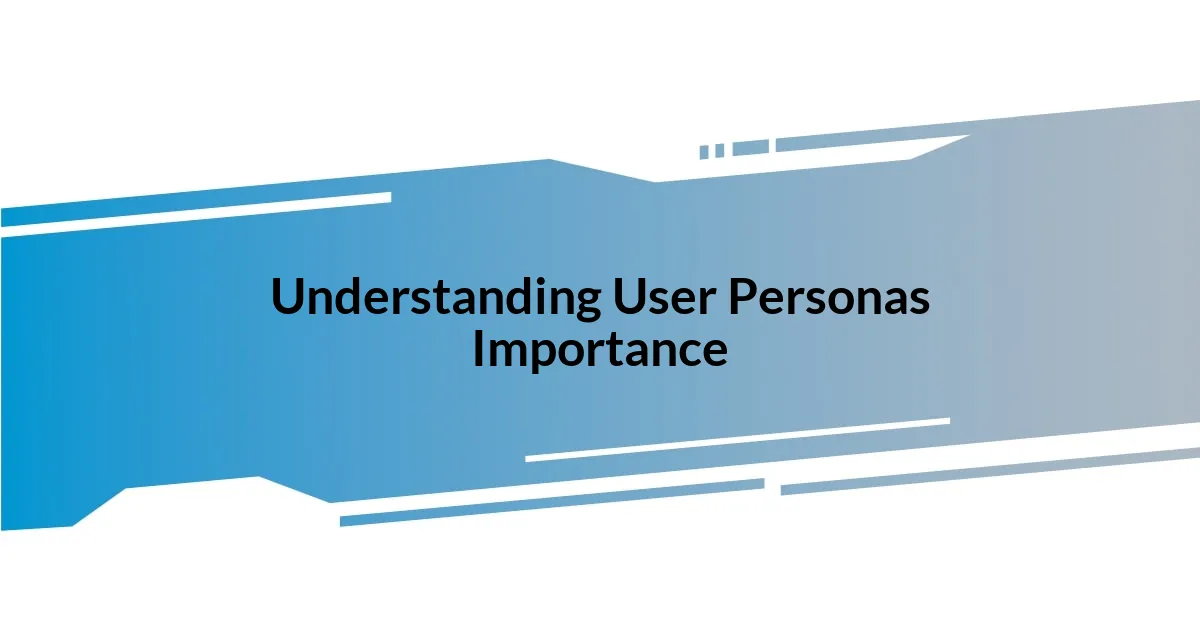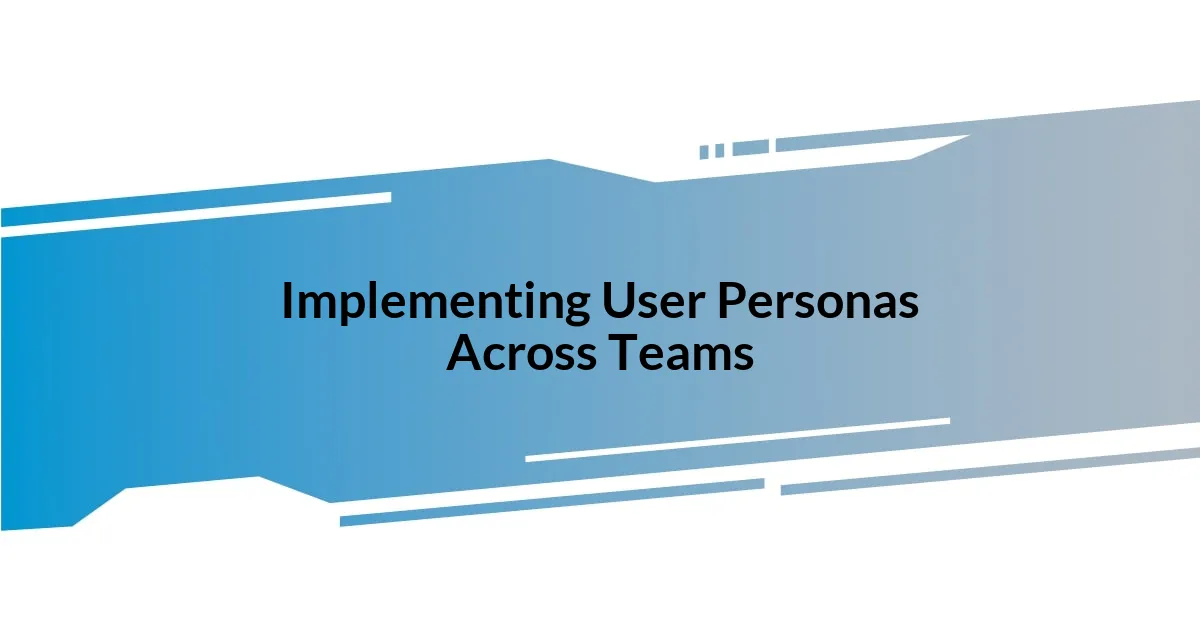Key takeaways:
- User personas transform abstract user concepts into relatable characters, enhancing engagement and design focus.
- Empathy mapping helps visualize users’ emotional landscapes, leading to solutions that cater to their real needs.
- Integrating user personas across teams fosters collaboration and creates a unified strategy, improving user experience.
- Measuring impact involves qualitative feedback, turning user experiences into compelling stories that guide design decisions.

Understanding User Personas Importance
User personas are vital because they bring story-like clarity to our audience. I remember when I created my first set of personas; suddenly, the abstract concepts of “users” transformed into real individuals with hopes, needs, and frustrations. It was like flipping a switch—seeing my designs not just as a product but as solutions for my crafted characters made all the difference.
Understanding the emotional landscape of these personas allows us to create more impactful experiences. For instance, during a project aimed at first-time users, I realized that fear of failure was a huge barrier. This insight pushed me to design onboarding processes that catered specifically to these anxieties, ultimately leading to better engagement.
Have you ever found yourself lost trying to cater to a broad audience? Embracing user personas means I no longer waste time guessing; instead, I focus on meaningful details. The specificity of personas streamlines decision-making, making the design process feel less daunting and more directed.

Identifying Target Audience Needs
Identifying the needs of my target audience became an enlightening process. Initially, I thought gathering demographics would suffice, but it was the deeper emotional insights that truly mattered. For example, I once tackled a project for small business owners who felt overwhelmed by technology. I listened to their stories, which revealed they craved not just tools, but also reassurance and support, guiding me to tailor solutions that provided resources and a sense of community.
As I continued refining user personas, I discovered the power of empathy mapping, a technique that helped me visualize users’ experiences, feelings, and pain points. This exercise not only clarified what my audience wanted but also how they wanted to feel while interacting with my products. I recall when a user highlighted their frustration when tools didn’t align with their workflow. This feedback was pivotal, shaping features that respected their routines and made their lives easier.
I often ask myself, “What keeps my users awake at night?” Understanding their challenges on a personal level allows me to create solutions that resonate. I remember when a struggling freelancer shared how disorganized platforms drained their creativity. Knowing this, I focused on designing intuitive interfaces that harmonized their work processes, ultimately fostering their creativity instead of stifling it.
| Audience Type | Identified Need |
|---|---|
| Small Business Owners | Reassurance and support in tech usage |
| Freelancers | Organization tools that foster creativity |

Creating Detailed User Profiles
Creating detailed user profiles is where the magic truly happens. I’ve found that diving into the minutiae of each persona transforms them from static representations into vibrant characters. For instance, when I worked on a fitness app, I created a persona named “Busy Brenda.” I envisioned her life, filled with work commitments and family responsibilities, and all the hurdles she faced in finding time to exercise. This visualization didn’t just inform design decisions; it ignited a passion in me to devise solutions that fit her lifestyle seamlessly.
When constructing user profiles, I focus on several key aspects:
- Demographics: Age, gender, location, and occupation.
- Psychographics: Values, interests, and lifestyle preferences.
- Goals and Motivations: What drives them to seek solutions?
- Frustrations and Pain Points: Challenges that hinder their success.
- Behaviors: How they interact with products or services in their daily lives.
I remember crafting Brenda’s daily routine, which allowed me to empathize with her struggles and tailor features that respected her time. Understanding how she juggled multiple priorities informed functionalities like quick workout options, which directly spoke to her needs. Ultimately, these profiles shaped my designs to foster connection and usability, building a bridge between the user’s reality and the product experience.

Utilizing User Personas for Insights
Utilizing user personas for insights goes beyond mere character sketches; it’s about unlocking a profound understanding of user motivations. I remember delving into a project for a tech-savvy audience and realized that their hesitations stemmed from feeling overwhelmed by rapid innovations. Asking questions like, “What do they value most in a product?” allowed me to pivot my approach, focusing on how to simplify and clarify complex features. This process illuminated the need for straightforward tutorials that not only informed but also empowered users to embrace change.
The real gems of insight often lie in the silent moments of user interactions. I recall a time when monitoring user sessions revealed that many users lingered on pages without clicking onward. This behavior pointed to confusion rather than disinterest. It was through analyzing these nuances from my personas that I recognized the importance of intuitive design elements, pushing me to create clearer paths for users, leading to better engagement. By continuously assessing how personas interacted with the product, I could make informed adjustments that enhanced their overall experience.
What if I told you that user personas can also spark creativity in ways I never anticipated? During a brainstorming session, I found myself channeling “Busy Brenda” once again, picturing her balancing work and family. This led me to propose features like a customizable dashboard that could streamline her daily tasks. Having such a vivid persona in my mind made it easier to ideate solutions that resonated with users’ lifestyles. This experience solidified my belief that user personas aren’t just tools; they are dynamic resources that breathe life into design, guiding us toward more impactful outcomes.

Implementing User Personas Across Teams
Integrating user personas across various teams has been a pivotal aspect of my process. For instance, my design team and marketing team once collaborated on a project targeted at young parents. I vividly recall a meeting where we shared our respective insights about the “Overwhelmed Olivia” persona. Hearing different perspectives on her challenges, such as managing time for both work and children, painted a fuller picture and led us to unify our strategies. This collaboration not only strengthened our messaging but also created a seamless user experience.
What I’ve noticed is that these personas often act as a common language across departments. In one memorable project, I worked closely with the customer support team while developing a persona named “Tech-Savvy Tom.” By considering Tom’s preferences and potential pain points, we aligned on more effective support resources. I found that everyone—from developers to marketers—became genuinely invested in understanding Tom’s journey, ensuring we addressed his needs holistically. It was rewarding to see how a shared understanding freed us from silos, fostering innovation.
Perhaps you’ve experienced the challenge of miscommunication among teams. When I first introduced personas at my previous workplace, resistance was palpable. But as people began to visualize users as real individuals, skepticism transformed into enthusiasm. I remember one colleague saying, “I thought I was designing for everyone, but now I see I was missing the essence of our users.” This shift in mindset not only empowered the team to create more tailored products but also strengthened our cohesion as we rallied around a collective mission. Engaging with user personas consistently fostered a deeper connection among us, reminding us that behind every statistic is a person with dreams and dilemmas.

Measuring Impact of User Personas
Understanding the true impact of user personas requires more than just analyzing initial data. I vividly recall a milestone moment when I gathered feedback after launching a feature tailored to “Minimalist Maya.” Surprisingly, the data didn’t reflect the expected outcome. Instead of mere numbers, I listened to users sharing their experiences, and it hit me—while the design was sleek, it didn’t align with Maya’s desire for functionality over aesthetics. This shift in focus from metrics to meaningful feedback allowed me to iterate and enhance the feature in ways that genuinely resonated with her needs.
Measuring the impact of user personas brings an element of storytelling into the equation. One time, during a review session, we showcased real user stories that embodied “Curious Chris.” Watching the team react to Chris’s journey was fascinating. Each emotional response mirrored our own personal challenges within the project, and it transformed our metrics from mere statistics into compelling narratives that motivated action. Have you ever felt that electrifying moment when the data tells a story? I can tell you, it ignites a passion in the team that pure numbers can rarely achieve.
What really got me thinking were the tangible outcomes we associated with our personas. After analyzing user behavior linked to “Budget-Conscious Betty,” we noticed a significant uptick in engagement when we addressed her financial concerns. It was a simple tweak—highlighting cost-saving features in our messaging. This not only validated Betty’s persona but also demonstrated a clear ROI. Have you experienced a similar breakthrough? Recognizing how user personas can directly influence success metrics filled me with a sense of purpose in my work, as it showed how deeply user insights could steer our projects toward success.